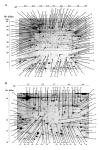Two-dimensional gel proteome reference map of blood monocytes
- PMID: 16948843
- PMCID: PMC1634993
- DOI: 10.1186/1477-5956-4-16
Two-dimensional gel proteome reference map of blood monocytes
Abstract
Background: Blood monocytes play a central role in regulating host inflammatory processes through chemotaxis, phagocytosis, and cytokine production. However, the molecular details underlying these diverse functions are not completely understood. Understanding the proteomes of blood monocytes will provide new insights into their biological role in health and diseases.
Results: In this study, monocytes were isolated from five healthy donors. Whole monocyte lysates from each donor were then analyzed by 2D gel electrophoresis, and proteins were detected using Sypro Ruby fluorescence and then examined for phosphoproteomes using ProQ phospho-protein fluorescence dye. Between 1525 and 1769 protein spots on each 2D gel were matched, analyzed, and quantified. Abundant protein spots were then subjected to analysis by mass spectrometry. This report describes the protein identities of 231 monocyte protein spots, which represent 164 distinct proteins and their respective isoforms or subunits. Some of these proteins had not been previously characterized at the protein level in monocytes. Among the 231 protein spots, 19 proteins revealed distinct modification by protein phosphorylation.
Conclusion: The results of this study offer the most detailed monocyte proteomic database to date and provide new perspectives into the study of monocyte biology.
Figures



Similar articles
-
Proteomic analysis of circulating human monocytes in coronary artery disease.Mol Cell Biochem. 2012 Jan;360(1-2):181-8. doi: 10.1007/s11010-011-1055-3. Epub 2011 Sep 22. Mol Cell Biochem. 2012. PMID: 21938407
-
Proteome comparison of alveolar macrophages with monocytes reveals distinct protein characteristics.Am J Respir Cell Mol Biol. 2004 Sep;31(3):322-9. doi: 10.1165/rcmb.2004-0080OC. Epub 2004 May 6. Am J Respir Cell Mol Biol. 2004. PMID: 15130903
-
Nano-scale proteomics approach using two-dimensional fibrin zymography combined with fluorescent SYPRO ruby dye.J Biochem Mol Biol. 2004 May 31;37(3):298-303. doi: 10.5483/bmbrep.2004.37.3.298. J Biochem Mol Biol. 2004. PMID: 15469710
-
Comparison of SYPRO Ruby and Flamingo fluorescent stains for application in proteomic research.Anal Biochem. 2010 Mar 1;398(1):1-6. doi: 10.1016/j.ab.2009.07.055. Epub 2009 Nov 14. Anal Biochem. 2010. PMID: 19917264
-
A reference map of human nasopharyngeal squamous carcinoma proteome.Int J Oncol. 2007 May;30(5):1077-88. Int J Oncol. 2007. PMID: 17390009
Cited by
-
Identification and validation of SRC and phospho-SRC family proteins in circulating mononuclear cells as novel biomarkers for pancreatic cancer.Transl Oncol. 2011 Apr 1;4(2):83-91. doi: 10.1593/tlo.10202. Transl Oncol. 2011. PMID: 21461171 Free PMC article.
-
Mass spectrometry based proteomics profiling of human monocytes.Protein Cell. 2017 Feb;8(2):123-133. doi: 10.1007/s13238-016-0342-x. Epub 2016 Nov 22. Protein Cell. 2017. PMID: 27878450 Free PMC article.
-
Optimization of protein solubilization for the analysis of the CD14 human monocyte membrane proteome using LC-MS/MS.J Proteomics. 2009 Nov 2;73(1):112-22. doi: 10.1016/j.jprot.2009.08.008. Epub 2009 Aug 24. J Proteomics. 2009. PMID: 19709643 Free PMC article.
-
Proteome of monocyte priming by lipopolysaccharide, including changes in interleukin-1beta and leukocyte elastase inhibitor.Proteome Sci. 2008 May 20;6:13. doi: 10.1186/1477-5956-6-13. Proteome Sci. 2008. PMID: 18492268 Free PMC article.
-
Phosphoproteins regulated by heat stress in rice leaves.Proteome Sci. 2011 Jun 30;9:37. doi: 10.1186/1477-5956-9-37. Proteome Sci. 2011. PMID: 21718517 Free PMC article.
References
-
- Fedorko ME, Hirsch JG. Structure of monocytes and macrophages. Semin Hematol. 1970;7:109–124. - PubMed
-
- Johnston RBJ. Current concepts: immunology. Monocytes and macrophages. N Engl J Med. 1988;318:747–752. - PubMed
-
- Koski GK, Lyakh LA, Cohen PA, Rice NR. CD14+ monocytes as dendritic cell precursors: diverse maturation-inducing pathways lead to common activation of NF-kappab/RelB. Crit Rev Immunol. 2001;21:179–189. - PubMed
Grants and funding
LinkOut - more resources
Full Text Sources

